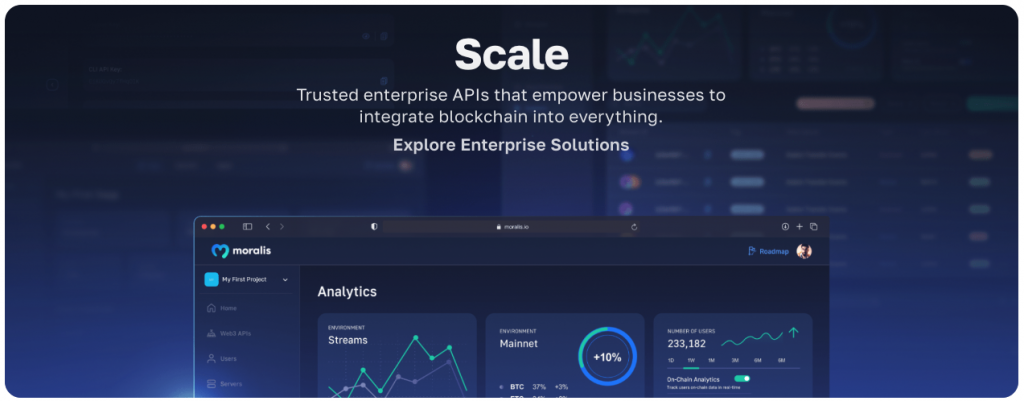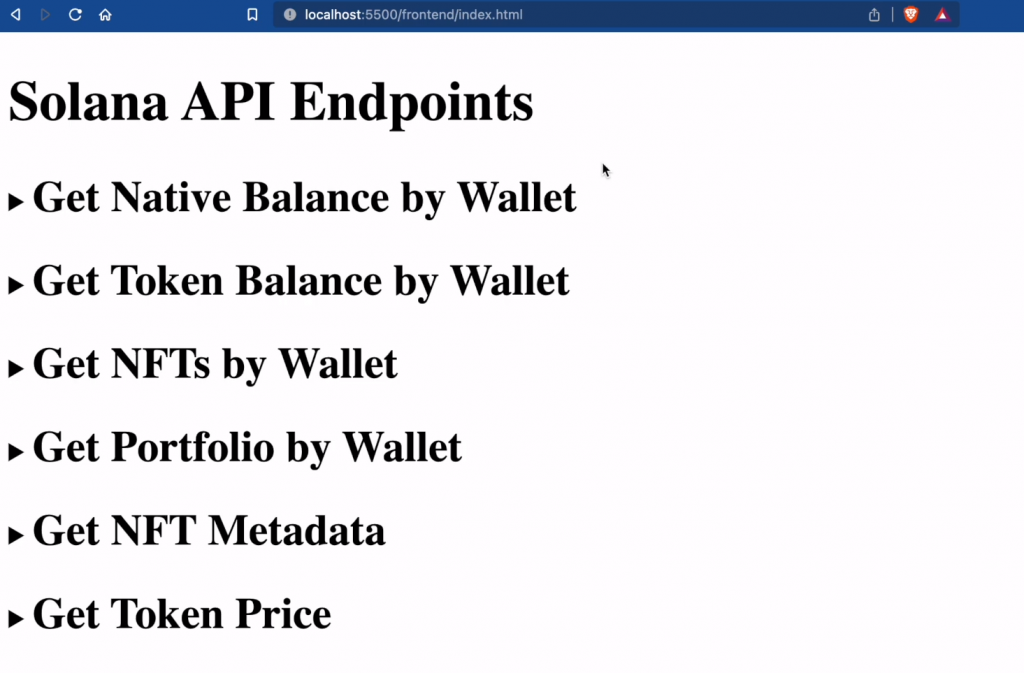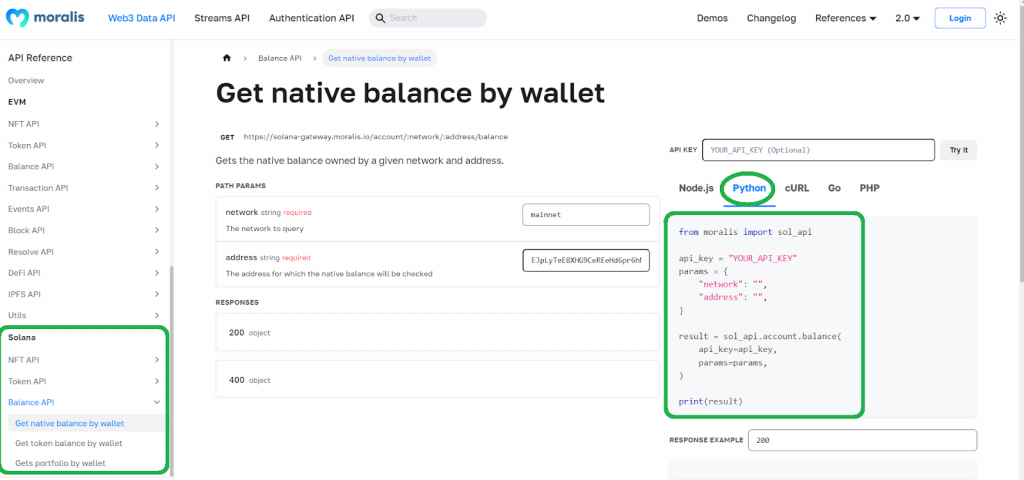[ad_1]
At the moment’s tutorial will present you how you can create a Python backend dapp that makes use of Solana API endpoints from Moralis. You’ll be capable to get native, fungible, and NFT balances and portfolios by pockets addresses. You’ll additionally discover ways to get NFT metadata and token costs. Due to Moralis’ Solana Python API, you may, for instance, fetch pockets balances with the next code snippet:
@app.publish(“/getWalletbalance”)
def getWalletbalance():
physique = request.json
params = {
“tackle”: physique[“address”],
“community”: physique[“network”]
}
consequence = sol_api.account.stability(
api_key= moralis_api_key,
params = params
)
return consequence
The traces of code for the opposite 5 endpoints are fairly comparable. Basically, they only change “getWalletbalance” and “sol_api.account.stability“. So, do you wish to discover ways to work with Moralis’ Solana Python API and implement the above traces of code, together with the opposite 5 Solana API endpoints? If that’s the case, ensure that to create your free Moralis account and observe our lead!

Overview
The core of at present’s article will probably be our Solana Python API tutorial. By following our steps, you’ll be taught to finish the preliminary setup and implement all present Moralis Solana APIs. By cloning our current frontend dapp, additionally, you will be capable to check the backend functionalities. Since we have already got a NodeJS backend dapp that covers the identical six endpoints, this tutorial additionally demonstrates how you can simply transition from NodeJS to Python. So, if you wish to discover ways to use the Solana API in Python, roll up your sleeves and observe our steps.
The sections under the tutorial embrace the theoretical features of at present’s matter. That is the place you may be taught what Solana and Python are and uncover extra particulars about Moralis’ Solana Python API and the way Moralis can additional elevate your Web3 improvement sport on Solana and different common programmable chains. In any case, the endpoints you’ll implement by finishing at present’s tutorial are only a small a part of what Moralis provides.

Solana Python API Tutorial
As talked about above, we are going to use the frontend we created as a part of our Solana JavaScript improvement. Which means we are going to merely change our NodeJS backend with Python with out affecting the frontend.

So, right here is our easy frontend enabling you to make the most of the facility of the Solana API endpoints. In fact, the precise performance relies on the backend that we are going to concentrate on herein. Here’s a screenshot of our frontend dapp:

Observe: If you happen to’re involved in exploring the code behind the frontend dapp, use the video on the high, beginning at 1:05. Plus, you may entry the whole frontend script – “index.html” – on GitHub. In actual fact, so as to check the backend that you just’re about to construct utilizing Python, we encourage you to clone our frontend.
Earlier than we present you how you can use the Solana Python API, you have to full the mandatory setups. That mentioned, the next part focuses particularly on at present’s instance mission; for those who choose to make use of extra basic “Python and Web3” setup directions, ensure that to make use of our Web3 Python documentation web page.
Python Backend Setup
You need to have already got a “frontend” folder inside your “Solana API demo” mission that incorporates the above-mentioned “index.html” script. If you happen to determined to clone our NodeJS backend, you may need a “backend” folder there as properly. That is what we’re beginning with:

Our first step is to create a “python-backend” folder. We do that by coming into the next command into our terminal:
mkdir python-backend
Then, we “cd” into this new folder:
cd python-backend
Subsequent, we create a brand new digital atmosphere for putting in and utilizing Python modules. We do that with the command under:
Python3 -m venv venv
Earlier than we are able to use the digital atmosphere, we additionally must activate it:
For that objective, we run the next command:
supply venv/bin/activate
Then, we additionally want to put in Flask, Flask CORS, Moralis, and Python “dotenv” modules:
pip set up flask flask_cors moralis python-dotenv
As soon as the above modules are put in, our digital atmosphere is prepared for use. As such, we are able to proceed with organising the atmosphere variables. That is the place we’ll retailer the Moralis Web3 API key, which is the important thing to accessing the facility of Moralis’ Solana Python API. So, in case you haven’t created your Moralis account but, ensure that to take action now. Then, you’ll be capable to copy your Web3 API key out of your admin space in two clicks:
When you have your NodeJS backend information in the identical mission, you may merely copy the “.env” file from there and paste it into your “python-backend” folder. In any other case, create a brand new “.env” file. Inside that file, you might want to have the “MORALIS_API_KEY” variable that holds the above-obtained API key as a price.
Now that now we have our digital atmosphere prepared, we are able to concentrate on implementing Solana Python API endpoints.
The way to Use the Solana API in Python
To implement the Solana Python API endpoints, we have to create a brand new “index.py” file inside our “python-backend” folder. On the high of that script, we import the above-installed packages:
from flask import Flask, request
from flask_cors import CORS
from moralis import sol_api
from dotenv import dotenv_values
Subsequent, we have to guarantee this script obtains our Web3 API key from the “.env” file:
config = dotenv_values(“.env”)
moralis_api_key = config.get(“MORALIS_API_KEY”)
We outline a variable “app” utilizing Flask within the following line, and we additionally embrace “CORS” in that variable:
app = Flask(__name__)
CORS(app)
We would like our backend dapp to run on port 9000 (the identical as our NodeJS backend). That approach, we don’t want to change the URL in our frontend. So, we add the next code snippet on the backside of our script:
if __name__ == “__main__”:
app.run(debug=True, host=”0.0.0.0″, port=9000)
With the above traces of code in place, we are able to begin implementing Moralis’ Solana API endpoints:
Steadiness API endpoints: Get native stability by walletGet token stability by walletGet portfolio by pockets Token API endpoints: NFT API endpoints: Get NFTs by walletGet NFT metadata
As a substitute of ranging from scratch, you may at all times copy code snippets for every endpoint from the API reference pages contained in the Moralis documentation. Right here’s an instance:

Implementing Solana Python API Endpoints
In our “index.py” script, slightly below the “CORS(app)” line, we have to outline routes and capabilities for every endpoint. Beginning with the “get native stability by pockets” endpoint, the traces of code within the intro do the trick.
With “@app.publish(“/getWalletbalance”)“, we create a brand new route in Python. Then, we use “def getWalletbalance():” to outline the operate for this endpoint. Contained in the operate, we learn the JSON information with “physique = request.json“. Subsequent, we outline the endpoint’s parameter (all Moralis Solana API endpoints solely require the “tackle” and “community” parameters). Then, we use the “sol_api.account.stability” technique on our parameters and Web3 API key and retailer its information beneath the “consequence” variable. Lastly, we return outcomes by returning the “consequence” variable. Once more, listed below are the traces of code for the “getWalletbalance” endpoint:
@app.publish(“/getWalletbalance”)
def getWalletbalance():
physique = request.json
params = {
“tackle”: physique[“address”],
“community”: physique[“network”]
}
consequence = sol_api.account.stability(
api_key= moralis_api_key,
params = params
)
return consequence
Different endpoints observe the very same rules; we solely want to vary the routes, operate names, and strategies accordingly. Under are the snippets of code for the remaining 5 Solana Python API endpoints.
The traces of code for the “getTokenbalance” endpoint:@app.publish(“/getTokenbalance”)
def getTokenbalance():
physique = request.json
params = {
“tackle”: physique[“address”],
“community”: physique[“network”]
}
consequence = sol_api.account.get_spl(
api_key= moralis_api_key,
params = params
)
return consequence The traces of code for the “getNfts” endpoint: @app.publish(“/getNfts”)
def getNfts():
physique = request.json
params = {
“tackle”: physique[“address”],
“community”: physique[“network”]
}
consequence = sol_api.account.get_nfts(
api_key= moralis_api_key,
params = params
)
return consequence The traces of code for the “getPortfolio” endpoint:@app.publish(“/getPortfolio”)
def getPortfolio():
physique = request.json
params = {
“tackle”: physique[“address”],
“community”: physique[“network”]
}
consequence = sol_api.account.get_portfolio(
api_key= moralis_api_key,
params = params
)
return consequence The traces of code for the “getNFTMetadata” endpoint:@app.publish(“/getNFTMetadata”)
def getNFTMetadata():
physique = request.json
params = {
“tackle”: physique[“address”],
“community”: physique[“network”]
}
consequence = sol_api.nft.get_nft_metadata(
api_key= moralis_api_key,
params = params
)
return consequence The traces of code for the “getTokenPrice” endpoint:@app.publish(“/getTokenPrice”)
def getTokenPrice():
physique = request.json
params = {
“tackle”: physique[“address”],
“community”: physique[“network”]
}
consequence = sol_api.token.get_token_price(
api_key= moralis_api_key,
params = params
)
return consequence
Observe: You may entry the whole “index.py” script in our GitHub repo.
Testing Our Python Backend
Whereas contained in the “python-backend” folder, we use our terminal to run the “index.py” script with the next command:
Python3 index.py
This begins our backend on port 9000. Subsequent, we have to begin our frontend. We do that with the “Stay Server” extension in Visible Studio Code (VSC) by right-clicking our “index.html” script within the file tree:
Then, we use our frontend dapp by coming into the required values, choosing the community kind, and hitting the set off button. Listed here are two examples:
The “Get Native Steadiness by Pockets” function:
The “Get Token Steadiness by Pockets” function:
In fact, the opposite 4 options work in the identical method.
Exploring Solana, Python, and the Main Web3 API Supplier
The next sections are for these of you who’re new to Solana or Python programming. These sections merely clarify what Solana and Python are, and as soon as you understand the fundamentals, you may additional discover how Moralis can support in your Solana programming endeavors.
What’s Solana?
Solana is a public and open-source programmable blockchain that helps sensible contracts. The latter are referred to as “packages” on Solana. Through these on-chain packages, Solana additionally helps the creation of fungible and non-fungible tokens (NFTs) and all kinds of dapps (decentralized purposes). In case you are acquainted with Ethereum or another programmable chain, you most likely know that they often keep native cash. Solana isn’t any exception with its native coin, “SOL”. The SOL asset primarily supplies community safety through Solana’s hybrid DeFi staking consensus. SOL can also be the foreign money used to cowl transaction charges on Solana and may function a way to switch worth on the Solana chain.
Anatoly Yakovenko and Raj Gokal are the 2 main builders who launched Solana again in 2017. Each Yakovenko and Gokal are nonetheless considerably concerned with Solana Labs – a expertise firm that builds merchandise, instruments, and reference implementations to additional develop the Solana ecosystem.
In case you are involved in studying extra in regards to the Solana community, learn considered one of our previous articles that dive deeper into the “what’s Solana?” matter.
What’s Python?
Python is a well-liked object-oriented, high-level programming language bellowed by quite a few builders. In any case, it has a fairly lengthy historical past – it’s been on the display screen since 1991. Plus, there are numerous resemblances between Python and different programming languages, resembling Ruby, Scheme, Perl, and Java. Python was designed by the developer Guido van Rossum, who sought to make it as easy as potential. Those that know and use Python declare it’s fairly simple to get began with, simple to be taught, and straightforward to make use of. Furthermore, based on “python.org“, this programming language enables you to work rapidly and combine techniques extra successfully.
In comparison with JavaScript, which continues to be the preferred programming language, Python has fewer customers. Nonetheless, it’s among the many high programming languages and is discovering its approach into Web3 improvement as properly. Apart from Solana dapps, you may also use Python for Ethereum improvement and all different EVM-compatible chains.

Solana Python API by Moralis
If you happen to took on at present’s tutorial, you had an opportunity to be taught in regards to the present Moralis Solana API endpoints. You even had a chance to implement them utilizing the Solana Python API – the instrument that allows you to develop dapps on Solana utilizing Python. As such, you now know how you can fetch NFT metadata, pockets portfolios, token balances, SPL token costs, and extra. As such, you should utilize this superb instrument to create killer dapps. For example, you may construct NFT marketplaces, token worth feeds, portfolio apps, and even Web3 video games. Moralis additionally helps each the Solana mainnet and Solana devnet. The latter allows you to check your dapps earlier than taking them dwell.
There’s one other useful gizmo you should utilize when creating decentralized purposes – Moralis’ Web3 Auth API. The latter allows you to implement Web3 signups and logins on Solana and lots of different blockchains. So, other than the Solana Python API, Moralis allows you to use Python to create dapps on all main blockchains. Whenever you concentrate on Ethereum and EVM-compatible chains, you may also hearken to sensible contracts and real-time pockets occasions with the Moralis Streams API. This additional expands the vary of functionalities you may cowl along with your dapps.
If you happen to’d wish to discover different improvement matters and observe alongside in different step-by-step tutorials, ensure that to take a look at how you can “create ERC20 token” and get Goerli ETH. Or, discover how you can simply calculate gwei to ether utilizing an already-developed calculator!
Solana Python API – The way to Use the Solana API in Python – Abstract
Solana is without doubt one of the hottest non-EVM-compatible blockchains. On the identical time, Python continues to realize recognition amongst Web3 builders. With that in thoughts, figuring out how you can take advantage of a dependable Solana Python API could make all of the distinction when growing dapps. Due to at present’s tutorial, you understand that to begin working with this highly effective API instrument, you solely want a free Moralis account.
In case you are severe about Solana improvement, you must also know how you can reply the “what’s a Solana pockets?” query. In time, you’ll additionally wish to discover Solana sensible contract constructing. Nonetheless, you can begin by taking a look at some Solana sensible contract examples. In any case, the correct of verified contract is without doubt one of the important Solana NFT mint instruments and arguably the simplest technique to create NFTs.
Whether or not you wish to concentrate on constructing dapps on Solana or another main blockchain, Moralis has your again. You need to use JS, Python, or many different Moralis SDKs to affix the Web3 revolution. Plus, Moralis’ YouTube channel and crypto weblog might help you develop into a Web3 developer without spending a dime.
Nonetheless, it’s possible you’ll be involved in taking a extra skilled strategy to your blockchain improvement. In that case, it is best to contemplate enrolling in Moralis Academy. There, you’ll get to attend many pro-grade programs, such because the “Solana Programming 101” course!
[ad_2]
Source link
